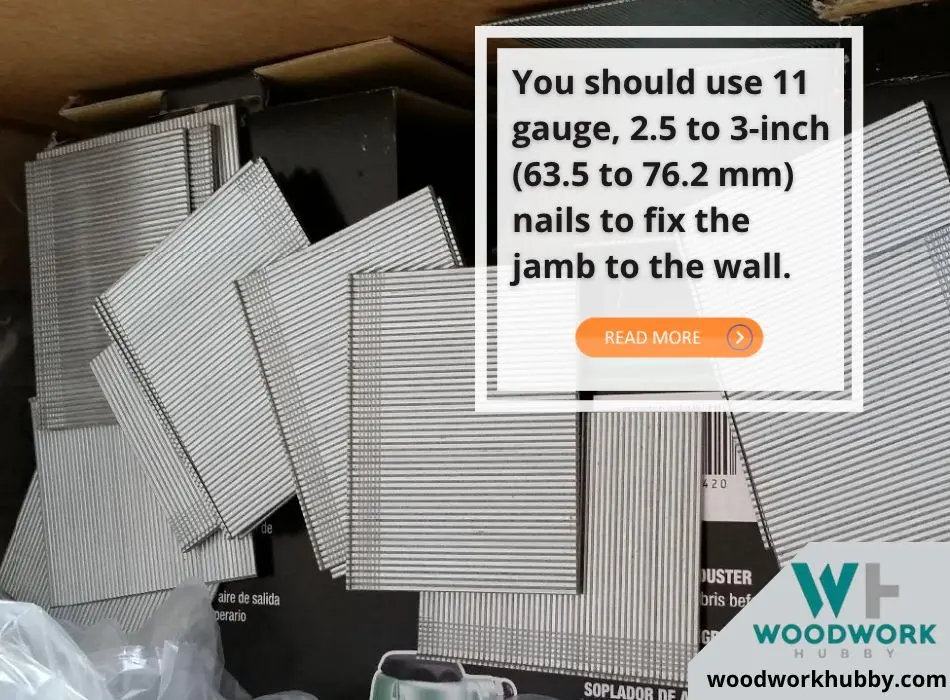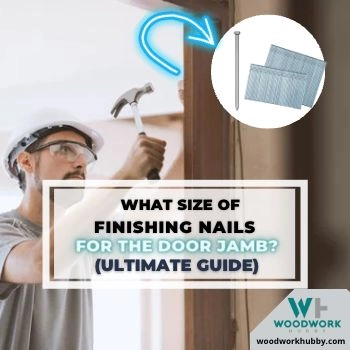Door frames are aesthetic and functional. Any mistake in the installation can make door use inconvenient. When it comes to the door jamb and finish trim for the frame, nothing is more important than the nail size, as it affects the durability of the overall frame.
You should use 11 gauge, 2.5 to 3-inch (63.5 to 76.2 mm) nails to fix the jamb to the wall. 6D Finishing Nails would suffice for this and you should use 16 gauge nails for the finish trim or for fixing casing/decorative board to the jambs.

In this article, you will learn everything you need to know about nail selection for door jambs. You will also learn about the potential drawbacks of specific nail types, the best gauge range for different nails, and the best practices of door frame nailing. By the end of this post, you’ll know all that I learned about door frame carpentry in my 20 years of woodworking.
The Two Types Of Jamb Nailing
You can use nails in 2 ways when installing a doorjamb. The most common way to use nails for door jambs is as adhesive mechanisms for the frame. A nail that drives through a door jamb into the wall can be as long as you want it to be. As long as it doesn’t drive into a wire or pipe inside the wall, the nail can be of any length past 2x the thickness of the jamb.
The second type of nail is the one that attaches the casing to the door jamb. This is supposed to be just long enough to go reach the end of the jamb. It doesn’t look aesthetic if it pokes through the sides. In both instances, longer nails lead to the durability of the overall structure.
A video shows a man installing a door jamb using a finishing gun.
What Happens If The Finishing Nails Are Too Long?
If your finishing nails are too long, they may poke out beyond the structure (when used to pin the casing). But given that door jambs are not standalone structures and are surrounded by thick walls, nails much longer than necessary have no negative effect on the project.
What Happens If Finishing Nails Are Too Short?
If the finishing nails are too short, they might not lodge deep enough between the head and the side jambs to create a strong door frame. The unit’s integrity can be compromised if the door jambs are not fixed with a long enough finishing nail.
Long Vs. Short: Which Way To Lean
So the consequence of using a very long finishing nail is that it can poke through the other end of one of the jambs, making the frame look bad. But if the nail is too short, the frame itself might get compromised.
Using a long finishing nail is better than using a short one. If you err on the side of longer nails, the worst that can happen with your door jamb is that it will have a visible nail or a bent one. But if you use a finishing nail that’s too short, the door jamb frame might be vulnerable and weak.
How Long Should The Nails Be For The Door Jamb?
The nails for a door jamb should be at least twice as long as the thickness of both the jambs that are being nailed together. If you’re nailing through a 1.5-inch (38.1 mm) thick jamb, the nails must be 3 inches (76.2 mm) long. These are nails that pin the jamb to the door.
The nails that drive through the casing and into the jamb need to be longer since they need to exceed the thickness of two planks. It must be 3 times the thickness of the material.
Can You Use 18 Gauge Nails For The Door Jamb?
You can use 18 gauge nails to attach casing or decorative bars to the door jamb but not to attach the door jamb to the walls. The nails that fix the jamb to the wall need to be 11 gauge. Even relatively light jambs require a 16 gauge nail for finish trim.
The nail gauge refers to its thickness, and the lower digits usually convey a higher strength. Nails lower than 11 gauge aren’t long enough for jambs, so that can be set as the ideal gauge value. But if your door jamb is made of very thin or light wood, then you can use a 16 gauge nail.
What Size Nails Do You Use For Finish Trim?
Use 16 gauge finishing nails for finish trim and ensure that they aren’t long enough to poke out of the other end of the framing plank. If you have 15 gauge finishing nails, you can use them as well. Avoid nails that can poke beyond the wood they are being nailed into.
That might seem like a lot to consider. Fortunately, average finishing nails are not long enough to poke out the other end when used right. If the nail gun is not positioned the right way, though, it will blow apart your door jamb. In most cases, the following nails will work for the finish trim.
DEWALT Finish Nails 2.5, 16-Gauge.
Not only are 16-gauge finish nails appropriate for finish trim, but they also work for fixing the jamb to the wall. They can be used for window casings, crown molding installation, and multiple other finishing practices as they balance nail girth and length.
That said, you need a nail gun to use these because they can blow thin wood planks if driven with a hammer. Even in thick blocks finishing nails tend to bend if driven by a hammer. But given that this pack contains 2,500 nails, it can be said that bent nails aren’t as big of a problem.
This product listing has over 2,072 reviews and ratings that add up to a global collective average of 4.7 stars on a 5-star scale. 95% of its customers have given it 5 or 4 stars. Its ease of use and value-for-money features are given 4.4 stars. Overall, this gives the impression of being a broadly satisfactory product.
| Recommended Finishing Nails for Door Jamb | Where to Buy? |
|---|---|
| DEWALT Finish Nails, 2-1/2-Inch, 16GA, 2500 Count (Pack of 1)(DCS16250) | AMAZON |
| SHALL 16 Gauge Finish Nails, 2000-Count (1-1/4, 1-1/2, 2, 2-1/2 Inch) 16GA Galvanized Finishing Nails Assorted | AMAZON |
What Kind Of Nails Do I Use For Door Trim?
You can use brad nails or finishing nails for the door trim. The nails should not be thick enough to blow the door jamb or too thin to fix the trim. 2.5-inch (63.5 mm) nails are ideal as long as the door frame isn’t too thin.
An instructional video on how to install door casing.
Brad Nails Vs. Finishing Nails: Which Is Better For Door Trim?
Both brad nails and finishing nails have their own benefits. Brad Nails have chisel ends, while finish nails have a round, almost absent nail head. Finish nails are more cylindrical, while brad nails are wire-like.
You are less likely to blow out connections when using brad nails, provided you use the right orientation when nailing the wood. But if the trim material is dense and heavy, the brad nail might not work very well.
Brad nails also have a very limited scope of use. So if you buy them for your door’s finish trim, you might not be able to use them in other projects unless you have window casing that needs to be nailed.
Overall, finishing nails are better for most door jambs, while brad nails are best for exceptionally delicate trim work.
Best Practices Of Using Finish Nails For Door Jamb

Now that you know which gauge and size finish nails to use for the two main applications in door jamb installation let’s go over a few things you should keep in mind when working on this project.
Use A Nail That’s 2 To 3 Times Longer Than The Board
This is a very good rule of thumb to use in general. The board that is being nailed as a jamb or into a jamb has to be fixed properly. And physics dictates that the nail sticks through the board and into the structure behind it.
A 2.5-inch (63.5 mm) nail will not stick a 2-inch (50.8 mm) board into a wall or another board as firmly as a 5-inch nail (127 mm). Most door jambs need 2.5 to 3-inch (63.5 to 76.2 mm) finishing nails, but if yours is exceptionally thin or thick, you can use the 2x or 3x rule of thumb as a metric.
In line with this, you may want to check my article about why finishing nails keep bending.
Do Not Rely On Nails Alone
“To the man with a hammer, everything looks like a nail.” This cannot be truer than in the case of installing door jambs. Jambs use classic joinery like miter joints, standard adhesives like wood glue, and finishing nails to make and fix the door jamb.
Nails should not be your primary adhesive mechanism in the door jamb. Wood glue and miter joints should form the structure alongside the nails that pin the jambs against each other.
Use More Nails Than You Think You Need
The beauty of finishing nails is that you can paint over them and make them less obvious. Using multiple nails can lend strength to the overall structure. In every application except the finish trim, you can use more nails to stabilize the door frame. 2 to 3 nails can be used on each side jamb, and one nail can suffice for the head jamb. When it comes to finish trim, nails can split the wood, so it is wise not to be excessive.
Nail Trim Should Be Nailed In The End
Novice woodworkers might make the mistake of prematurely installing the trim onto the jamb. But this can make a weak overall fixture that is incredibly hard to install. Forget the trim entirely until the jambs are in place and have the stands upon which the trim can be nailed.
Do Not Use Nails For Hanging The Door
While finish nails are extremely versatile and can be used for a range of applications, they are poor options for hinge jambs. You need to use screws as they hold better, and the hinges can hide them. Nails can come loose, bearing the weight of the door.
Measure, Measure, and Measure
Finally, the most important practice in the door jamb and door m hanging is measuring. The more you measure, the better the outcome is. You need to take the following measurements:
- The width of the door jamb – This measurement will set the maximum limit for nailing the trim. The trim finish nails must not poke past the door jamb.
- The thickness/depth of the jambs – This measurement will help you decide the nail length for the jamb-to-wall fixing.
- The thickness/depth of the trim – This measurement will help you avoid blowing out the jamb.
- The proportions of the door and each side of the frame – Accounting for the proportions will help the overall project. If the jambs are proportionate, the door will work, and the frame will look good.
Final Thoughts
6D Finishing nails will work for fixing the jamb to the wall and the sides to each other. When it comes to nailing the trim, you will need leaner finishing nails of 16 gauge to 15 gauge measurement, depending on its thickness. Regardless of the nails you use, nailing the door frame requires care and precision, so be attentive, and mind the position and orientation of your nail gun.
-
What Size of Finishing Nails for Door Jamb (Ultimate Guide)

Door frames are aesthetic and functional. Any mistake in the installation can make door use inconvenient. When it comes to the door jamb and finish trim for the frame, nothing is more important than the nail size, as it affects the durability of the overall frame. You should use 11 gauge, 2.5 to 3-inch (63.5…




2 responses to “What Size of Finishing Nails for Door Jamb (Ultimate Guide)”
[…] See my handy chart below which will help with choosing your nail size. […]
[…] Finishing nails keep bending because of 1 of 3 causes. Bad hammer face, poor hammering technique or the wood species all can cause a finishing nail to bend. In 9 out of 10 cases, the nails get bent because they aren’t being hammered perpendicularly. But sometimes, it is the hardwood material or something impenetrable under the wood. […]